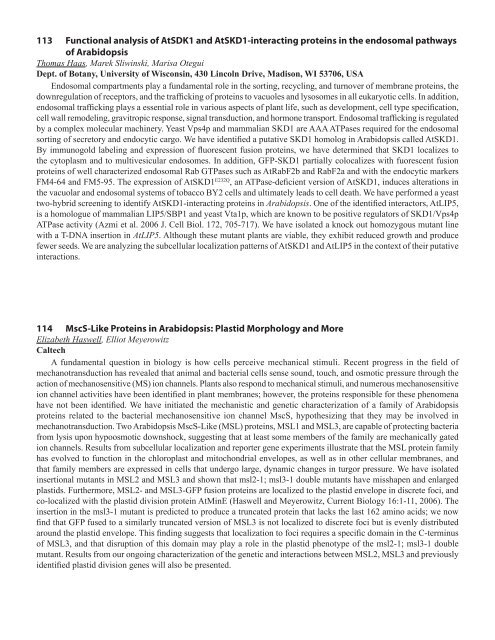75 Integrating Membrane Transport with Male Gametophyte ... - TAIR
75 Integrating Membrane Transport with Male Gametophyte ... - TAIR
75 Integrating Membrane Transport with Male Gametophyte ... - TAIR
Create successful ePaper yourself
Turn your PDF publications into a flip-book with our unique Google optimized e-Paper software.
113 Functional analysis of AtSDK1 and AtSKD1-interacting proteins in the endosomal pathways<br />
of Arabidopsis<br />
Thomas Haas, Marek Sliwinski, Marisa Otegui<br />
Dept. of Botany, University of Wisconsin, 430 Lincoln Drive, Madison, WI 53706, USA<br />
Endosomal compartments play a fundamental role in the sorting, recycling, and turnover of membrane proteins, the<br />
downregulation of receptors, and the trafficking of proteins to vacuoles and lysosomes in all eukaryotic cells. In addition,<br />
endosomal trafficking plays a essential role in various aspects of plant life, such as development, cell type specification,<br />
cell wall remodeling, gravitropic response, signal transduction, and hormone transport. Endosomal trafficking is regulated<br />
by a complex molecular machinery. Yeast Vps4p and mammalian SKD1 are AAA ATPases required for the endosomal<br />
sorting of secretory and endocytic cargo. We have identified a putative SKD1 homolog in Arabidopsis called AtSKD1.<br />
By immunogold labeling and expression of fluorescent fusion proteins, we have determined that SKD1 localizes to<br />
the cytoplasm and to multivesicular endosomes. In addition, GFP-SKD1 partially colocalizes <strong>with</strong> fuorescent fusion<br />
proteins of well characterized endosomal Rab GTPases such as AtRabF2b and RabF2a and <strong>with</strong> the endocytic markers<br />
FM4-64 and FM5-95. The expression of AtSKD1 E232Q , an ATPase-deficient version of AtSKD1, induces alterations in<br />
the vacuolar and endosomal systems of tobacco BY2 cells and ultimately leads to cell death. We have performed a yeast<br />
two-hybrid screening to identify AtSKD1-interacting proteins in Arabidopsis. One of the identified interactors, AtLIP5,<br />
is a homologue of mammalian LIP5/SBP1 and yeast Vta1p, which are known to be positive regulators of SKD1/Vps4p<br />
ATPase activity (Azmi et al. 2006 J. Cell Biol. 172, 705-717). We have isolated a knock out homozygous mutant line<br />
<strong>with</strong> a T-DNA insertion in AtLIP5. Although these mutant plants are viable, they exhibit reduced growth and produce<br />
fewer seeds. We are analyzing the subcellular localization patterns of AtSKD1 and AtLIP5 in the context of their putative<br />
interactions.<br />
114 MscS-Like Proteins in Arabidopsis: Plastid Morphology and More<br />
Elizabeth Haswell, Elliot Meyerowitz<br />
Caltech<br />
A fundamental question in biology is how cells perceive mechanical stimuli. Recent progress in the field of<br />
mechanotransduction has revealed that animal and bacterial cells sense sound, touch, and osmotic pressure through the<br />
action of mechanosensitive (MS) ion channels. Plants also respond to mechanical stimuli, and numerous mechanosensitive<br />
ion channel activities have been identified in plant membranes; however, the proteins responsible for these phenomena<br />
have not been identified. We have initiated the mechanistic and genetic characterization of a family of Arabidopsis<br />
proteins related to the bacterial mechanosensitive ion channel MscS, hypothesizing that they may be involved in<br />
mechanotransduction. Two Arabidopsis MscS-Like (MSL) proteins, MSL1 and MSL3, are capable of protecting bacteria<br />
from lysis upon hypoosmotic downshock, suggesting that at least some members of the family are mechanically gated<br />
ion channels. Results from subcellular localization and reporter gene experiments illustrate that the MSL protein family<br />
has evolved to function in the chloroplast and mitochondrial envelopes, as well as in other cellular membranes, and<br />
that family members are expressed in cells that undergo large, dynamic changes in turgor pressure. We have isolated<br />
insertional mutants in MSL2 and MSL3 and shown that msl2-1; msl3-1 double mutants have misshapen and enlarged<br />
plastids. Furthermore, MSL2- and MSL3-GFP fusion proteins are localized to the plastid envelope in discrete foci, and<br />
co-localized <strong>with</strong> the plastid division protein AtMinE (Haswell and Meyerowitz, Current Biology 16:1-11, 2006). The<br />
insertion in the msl3-1 mutant is predicted to produce a truncated protein that lacks the last 162 amino acids; we now<br />
find that GFP fused to a similarly truncated version of MSL3 is not localized to discrete foci but is evenly distributed<br />
around the plastid envelope. This finding suggests that localization to foci requires a specific domain in the C-terminus<br />
of MSL3, and that disruption of this domain may play a role in the plastid phenotype of the msl2-1; msl3-1 double<br />
mutant. Results from our ongoing characterization of the genetic and interactions between MSL2, MSL3 and previously<br />
identified plastid division genes will also be presented.





